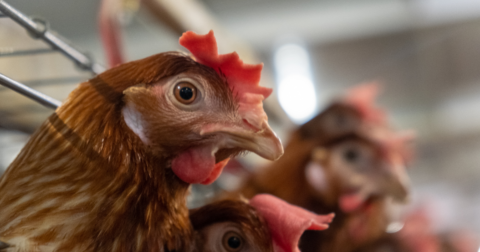Perspective
Critics Declared Veganism Dead in 2025. Here’s What Those Obituaries Are Missing.
Food•5 min read
Analysis
Layoffs and a declining stock price may signal trouble for the U.S.'s largest poultry producer


Words by Björn Ólafsson
Noel, Missouri is home to about 2,000 people in a tight-knit community — many of whom are refugees and immigrants from across the globe. As of two months ago, about three out of four Noel residents are looking for work now that the local Tyson chicken processing plant has closed its doors. The situation in Noel isn’t unique. Between May and November of this year, Tyson Foods, the poultry behemoth that slaughters 2.4 billion farm animals annually, announced a string of slaughterhouse closures and layoffs. The company did not respond to Sentient’s request for comment.
As we head into 2024, American meat production is still on the rise, but at a slower rate than what was once predicted. Companies like Tyson are citing overproduction and a flooded market, but recent research shows that meat consumption is also starting to slow or may even be declining. Between the slump in sales and stock price, Tyson’s terrible year has left thousands out of work, and lingering questions about the future of the cheap chicken industry.
News of Tyson chicken plant closures have dominated headlines all year, especially in Arkansas. In May, the biggest chicken producer in the country announced the closures of two facilities in Glen Allen, Virginia, and Van Buren, Arkansas – leaving nearly 1,600 people looking for new work.
In August, four more plants across Arkansas, Indiana and Missouri received the news that they would have to close their doors in early 2024. One such plant in North Little Rock has already shut down. Together, these four slaughterhouses were responsible for killing and processing a tenth of Tyson’s chickens. In November, Tyson announced the impending closure of one of its plants in Columbia, South Carolina and a factory in North Jacksonville, Florida, slated to shutter in January 2024. The company’s meatpacking plant workers have suffered mass layoffs, like 250 individuals in Wilkes County, North Carolina.
In total, eight Tyson facilities have either been closed or are slated for closure in 2024. Over 5,550 people have lost their jobs or been forced to relocate. These closures have devastated small towns like Noel, Missouri, sending ripples of financial loss throughout the rural communities affected.
Tyson’s closures and layoffs have disproportionately impacted the U.S. Latino community and refugees looking for work. The company has sometimes offered the employees relocation packages to other states, but only a minority of affected individuals have accepted the offers.
Tyson has also cut 10 percent of its corporate jobs. As of November, the company is reporting yearly sales down 0.8 percent from 2022.
The meat company has also weathered bad press, in particular due to a series of child labor law violations. In February, an investigation revealed that over a hundred children were illegally employed in slaughterhouses and meatpacking plants, one of which was owned by Tyson.
Then, in September, the Department of Labor opened an investigation into Tyson and Perdue after reports of immigrant children as young as 13 working night shifts in their facilities. Workers’ rights activists have been protesting Tyson since October.
In January, John R. Tyson, the CFO and grandson of the company’s founder, pled guilty to trespass and public intoxication after being found asleep in the bed of a female college student. Tyson’s board chose not to remove him from his position, despite the plea.
Tyson’s dwindling stock value has reflected these scandals. On May 8th, their stocks plunged 16 percent to a three-year low, and while it has recovered somewhat, their stock remains over 12 points below its January price, as of time of publication.
Tyson does not always give a reason for the closures but, when it does, explanations vary. Statements have sometimes cited “consumer demand” or “a struggling industry,” but also that the closures will “reduce costs and improve capacity utilization.” CEO Donnie King has said the low profits are due to too much protein on the market and that Tyson became “fat and lazy,” and has been coasting.
While it is unlikely that Tyson, or its massive competitors, are going under anytime soon, their recent series of closures might indicate the weakening power of the U.S. factory farm industry – a conglomerate that, until recently, has seemed untouchable.
Other companies also reported less than stellar profits in 2023. JBS’ third-quarter earnings dipped below 2022 levels and Cargill’s profits halved in 2023. And Smithfield Foods has recently ended contracts with 26 pig farms due to an oversupply of pork in the marketplace.
Historically, the chicken industry has been growing nearly every year since the USDA started tracking it. In 1960, 1.5 billion birds were slaughtered for American consumption, but that figure has swelled to over 9.5 billion chickens killed every year. Today, the average American eats about 68 pounds of chicken each year (as compared to 56 and 48 pounds of beef and pork, respectively). In fact, chicken overtook beef in 2010 as the most consumed meat in America.
Chicken is cheap, due mostly to the way industrial agriculture treats workers and farm animals. But with a product so cheap and popular, it seemed untouchable. In 2020, the USDA forecasted that the chicken industry would continue to grow every year by between 0.9 and 2.8 percent every year until 2030. Per capita consumption was expected to grow every year bar one: 2022.
However, the USDA recently revealed, in their monthly Poultry Outlook, that the estimated 2024 chicken production has been adjusted down by about 1.7 percent, as compared to the 2020 prediction. So while chicken production and consumption is still increasing, it is doing so at a decreasing rate, and below what was expected a few years ago. Globally, we see a similar story: a 2.5 increase was initially predicted but the industry only saw half of those gains.
There are a few potential reasons for this surprising slump. Record-high chicken prices are turning consumers away from the staple food while inventories are the highest they’ve ever been. Feed costs have gone up and the bird flu that’s stuck around since 2022 has wiped out millions of birds.
However, these problems pale in comparison to a decrease in demand. According to Vegconomist, as of October 2023, meat sales have dropped by 4 percent since the previous year. The drops are steepest for pork, turkey and seafood. And then there’s chicken: Tyson reported a 3 percent sales decline in August. This sagging consumption is in line with survey data from that same month finding 26 percent of Americans are reducing their meat consumption in 2023. Of course, it’s still too soon to tell for certain if this is a temporary blip — or if the U.S. will truly start to see a decline in the amount of meat we eat.
Look for the poultry giant to pivot in the year ahead. Tyson is venturing into new territory, hoping to attract new consumers. This past year, the organization unveiled a “climate-smart” beef program. This version of beef doesn’t make beef “sustainable” — it can only reduce about 10 percent of its sky-high greenhouse gas emissions — but the company is hoping this label will sway consumers who don’t know that beef is one of the worst foods for the climate you can consume.
Yet Tyson has also been expanding into alternative protein since 2019, offering up a line of plant-based chicken products, hoping to appeal to flexitarians and other consumers cutting back on meat.
The company’s CEO has expressed optimism for the future, arguing that the eight closed facilities were the least productive of Tyson’s factories. But industry experts aren’t expecting a significant pickup in chicken sales in 2024.
Ultimately, closed facilities and lower-than-expected chicken consumption aren’t going to sink Tyson — in fact, the higher prices of supermarket chicken and the removal of low-performing factories may even improve its bottom line, at least in the near future. But there does seem to be evidence of a shrinking appetite for beef, pork and even poultry. If that decline holds, it’s a trend that at the very least casts doubt on the company’s long-term success, and maybe even the future of cheap chicken.